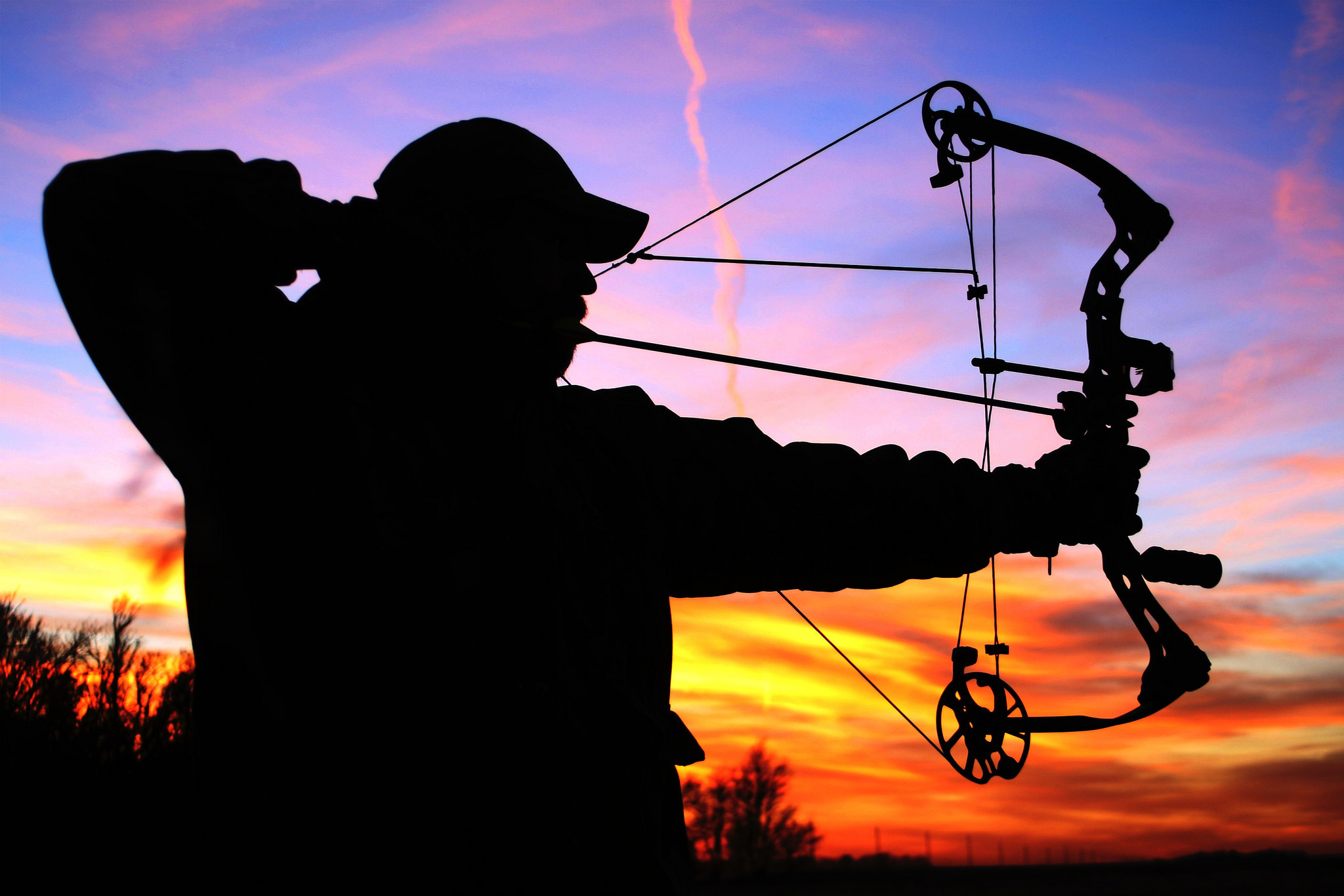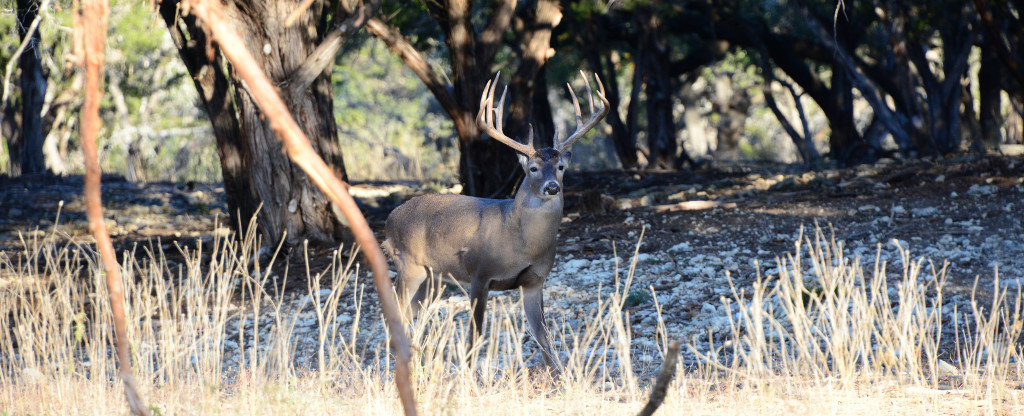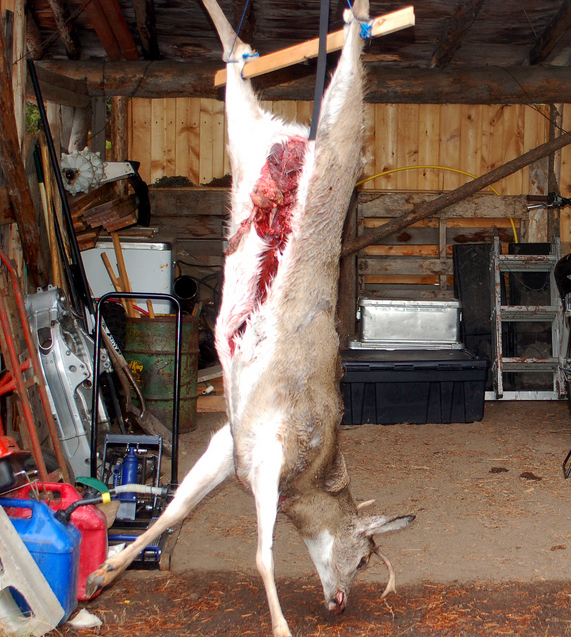After a few seasons every hunter develops their own recipe for success for the whitetail woods. Armed with a bow and arrow chasing whitetail deer is one of the great challenges for the American outdoorsman. It's always handy to have a few bow hunting tips and tricks up your sleeve. Here are the basics until you learn the ropes.

Image by Kansas Tourism
Bow Shooting Tips
1. Get an Easy to Use Bow
The short and lightweight crowd has taken over just about everything in the outdoors. Don’t too caught up in the hype. Get an appropriately long bow that has decent weight to stabilize the shot. The short and light bows make for easy carry but until you’re a seasoned bow hunter shy away from them.
If you think you need an ultralight bow, just shoot more. After a month or so of regular range sessions you’ll build up the muscles to hold the bow and shoot under pressure. For your first bow, or your last, the ability to place accurate arrows is the most important feature.
2. Simplify Your Pins
Archery sights are out of control. Whoever invented the 7-pin sights clearly never used it. Use as few pins on your sight as possible. Three or less is ideal and the new generation of single pin sights are great for new shooters who have yet to gain confidence in the woods.
A single pin sight can be used for most bows shooting at least 315fps. That means under pressure you’ll be able to place the pin where it needs to be and hit accurately without worrying about using the right pin.
If you insist on having a multi pin sight, make sure you know exactly what ranges go for each. If it helps write them down on an index card, hole punch it and hang it off to one side of the bow so you can study it until you see the pins in your sleep!
3. Get a Thin Grip
The grip of your bow is one of the #1 places you can skew your shot. When you go to shoot, you should have a fairly open and very even grip on the bow. This makes sure you’re not torqueing the bow in one direction or the other.
The best way to ensure you’re not going to muck it up under stress is by slimming down the diameter of the grip in the first place. That way there’s less surface area for you to act on.
Most bow manufacturers use a wraparound grip on their riser. Ditch it and find an ultra-thin profile grip. If you hunt with gloves on, leave it off entirely!
4. Adjust Your Release
The release is much like a trigger. In fact, if you’re using a traditional mechanical release with a wrist cuff and trigger blade it’s literally the trigger. Just like on a rifle, trigger control is important. However opposite of a rifle trigger, you need to wrap your whole hand around the blade of the trigger.
Reason being, is that you should be pulling the bow apart with the major muscles of the back and your hand should almost be limp. Wrapping your finger around the release rather than resting the tip on it allows you to "creep" it into firing. That way you don’t slap the release.
5. Use the Correct Lube
It’s important to make sure your gear is up to snuff when it’s time to let the hammer fall. Oiling the mechanical components of your bow is part of that. Making sure all the metal surfaces are corrosion free and ready to go, making sure the bow strings are waxed and not frayed and making sure the components work well is as much a performance concern as it is a safety concern.
You can’t just use any ol' lube for your bow. A scentless high quality oil is preferred because when you’re steps away from your trophy, they’ll certainly smell any harsh petroleum chemicals you used. Newer vegetable based products are odorless and durable enough to last all season. Spend the extra cash to be undetectable, it may pay dividends come opening day.
6. Ditch the Foam
The foam that lines the top of your quiver is a recipe for disaster. The foam can dull out a broadhead faster than a range session. Dull broadheads are more apt to break apart on impact. If a broadhead shears off, penetration will lack and you may mortally wound an animal you’ll never recover.
Find a quiver without foam or rip the foam out of your old standby. The idea behind the foam is to keep them from banging around too much. You'll find it isn’t missed when removed and could potentially save your hunt.
7. Quiver On or Quiver Off
Most hunters practice with a quiver off and then go into the woods with the quiver on, and then take it off when they get to the stand and hang it on a limb. There’s a solution...either put it on, or take it off.
Whichever way you choose make sure you practice with it the way you’ll have it when game time. This makes it muscle memory to know how it’ll feel when your shot comes and you won’t have new feel on top of nerves running.
8. Practice How You'll Shoot
One of the biggest mistakes hunters make is not having realistic practice. Very rarely, if ever will you be shooting from a perpendicular position, on level ground, with nothing in between you and your quarry. It’s going to be a messy and hectic scene when the time comes, so do everything you can to simulate how the real hunt will happen.
If you’re a ground blind hunter, shoot sitting in a ground blind. If treestands are your thing, practice shooting from a treestand. Lastly, if you can afford it, shoot at a 3D target. Everything you do that is more realistic will pay dividends in the field on opening morning.
Bow Hunting Tips for Beginners
9. Get Close
One of the whole reasons to bow hunt is so you can get closer to your game. One of the best tips for bow hunting whitetail deer is you can never be too close. Deer are jumpy, the closer you are the more room for error you have when it comes time for the arrow to fly, but you have much less room for error before. Be on your toes!
10. Know Your Ranges
Learn to recognize what a deer looks like at various ranges. This can mean reviewing photography, or even better, taking a 3D target out to your stand and observing. Misjudging a target’s distance is one of the biggest reasons you might miss, and you may not have time to use a laser rangefinder to check and see if what you’re doing is correct.
11. Learn Your Angles
The higher you go in the tree, the steeper the angle. That angle can be deceiving and cause a missed shot. If a deer jumps the string and is 4 yards from the base of your tree, you shouldn’t take the shot. The angle is so steep your chances of a double pass through are slim to none. Be a responsible hunter and know what’ll happen after the arrow flies.
12. Wait for the Opportune Moment
After the deer is in range the hardest part of deer hunting starts when the deer is actually in range. Ideally you would’ve heard the deer before you saw it and gotten ready before the deer could see you. You should always have an arrow nocked and your bow within arm’s reach. But that’s the easy part.
The hard part is drawing without being detected. Deer in fact look up, so the trick is to draw when they’re looking down. Don’t rush the shot, relax, breathe and wait for the opportune moment to get the drop on your quarry.
13. Stay in There
The learning curve for bow hunting is steep. Especially in high pressure areas and low deer density public land. Look for safe havens and areas where you can maximize your chances, enjoy small successes and stick with it.
Early Season Bow Hunting Tips
14. Cut Shooting Lanes Early
Every animal in the forest knows the smell of fresh cut bark. Go as early as you can to trim shooting lanes and hang stands. You need much more cover than a gun hunter because the deer will be within bad breath distance.
Fresh cut clipping should be hauled away, nothing in nature cuts branches off trees 20ft above the ground. The deer may not know it was human, but they will be weary when they see a clean cut through a healthy branch.
15. Don't Trim Too Much
Because the deer are much closer, you need more cover than most hunters who have the advantage of distance. Even if the wind is in your favor, you still need a fair amount of cover because the deer will see you draw your bow in their peripheral vision.
Limit yourself to one main shooting lane, and two "observation holes" on either side. Ideally, you’d hear the deer coming, see it pass through one of the "observation holes" and then kill it in the shooting lane. This is a good strategy for funnels and trails where you’re most likely to get spotted.
16. Don't Be Too Aggressive
There’s a ton of time left during the early season and you don’t want to put pressure on your deer that’ll blunt the rut and late season action. Make sure you respect bedding areas, core buck areas, and don’t track too much on main deer highways. Otherwise you’ll spook many, many deer you’ll never even see.
17. Hunt Afternoons
Deer in the early season will be a predictable eat-bed-eat pattern. They’ll head back to bed long before legal shooting light and you only stand to spook them. Unless you have hard evidence, trail cameras or firsthand observation telling you otherwise, hunting evenings will always be more effective in the early season.
Key into food sources and the "staging" areas the deer will spend time in before heading out into food plots or agriculture fields to feed. Key into the trails leading to these staging areas and you’re bound to fill tags.
18. Cycle Stands
The sure-fire way to ruin a stand site is by over-hunting it. Make sure you have more than a single stand or ground blind ready for action. The key here is to prep and have backup plans. If you’re a public land hunter make sure to have a half dozen different potential sites, as you never know when two minds think alike.
19. Fill Doe Tags
Don’t wait until the end of the season to fill doe tags. New research into QDMA has supported taking does in the early season. Not only is there more meat on the doe, but fawns that have lost their spots are more than likely going to survive without problem.
The other upside is you’re going to reduce the number of does going into estrus for the rut in your local population. That is going to increase the competition of mature bucks for receptive does during the peak of the rut.
After the Shot Tips
20. Have an Exit Plan
When you’re done hunting, have plans in place for what you’re going to do with your venison. Think about....what happens if there’s deer still under the stand after shooting light? What happens if you can’t find your deer? What if bad weather rolls in and you have trouble getting your deer out?
These are all situations that have lead to disaster. Make plans and let people know what they are. In my house, coordinates of my stands, instructions for all types of scenarios are left in an envelope taped to the fridge and also on my dashboard while in the field.
21. Avoid Deer Trails
On your way out of the woods avoid deer trails. Deer will smell the blood of other deer and be alarmed. They’ll also smell you all sweaty and excited and be alarmed as to why you’re walking down the trail. If you plan on hunting in that area again soon, resist the temptation to walk down the deer highways.
22. Be Hands Free
Dragging a deer out of the woods is a two-handed proposition. Plan to have your bow attached to your backpack or in a sling so that you have both hands free for dragging out the monster buck you killed.
Also be sure that any equipment, stands, extra clothing etc. Doesn’t hit your thighs as you stoop to drag the deer out. The worst thing ever is fighting gear and having to drag out a buck through the thick stuff. Plan ahead to make sure all your gear works together, not against each other.
23. Work Fast
When dressing a deer, don’t be in a hurry and botch the job, but you don’t exactly spend all the time in the world either. You’re either going to be battling heat in the early season or a hard freeze in the late season depending on your climate.
Have all the tools ready for your task at hand. A game cart, drag sled or a buddy can help you get your deer out quickly. Getting the deer dressed and cooled fast is the first step in great tasting venison and as a hunter you should do everything you can to make the meat as usable and high quality as possible.
24. Call for Help
If all else fails and you can’t find your deer, call for help. The first call should be to your family letting them know you’re OK and the next is your most experienced buddy who can help you trail the deer until you find it. The backup is a hound dog service.
Many hunt clubs have at least one old timer with a hound or two who’ll find your deer with his dogs for a nominal fee. Even if you think you’ll never use his service, plug his number into your phone. These guys are nice to have around in a pinch and are always a fountain of hunting wisdom when you get to talking with them.
25. Record Everything
The final bow hunting tip and trick is to record everything. Deer movement, times you were out, where you were, everything needs to be stored and collected so later you can reflect and think about the best way to approach your hunting situation.
Very few properties are alike and taking notes will allow you a way to learn more while you’re in the outdoors. Look for ways to connect the dots until you kill a mature buck, because the first one with a bow is a special treat. A hunt worth having, is a hunt worth recording!
Bow hunting tactics get collected from year to year and passed on. Once you spend a few seasons in the woods you’ll develop your own bow hunting tips and tricks to pass on to new bow hunters.



